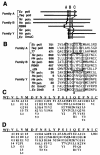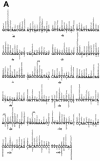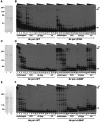Palm mutants in DNA polymerases alpha and eta alter DNA replication fidelity and translesion activity
- PMID: 15024063
- PMCID: PMC371111
- DOI: 10.1128/MCB.24.7.2734-2746.2004
Palm mutants in DNA polymerases alpha and eta alter DNA replication fidelity and translesion activity
Abstract
We isolated active mutants in Saccharomyces cerevisiae DNA polymerase alpha that were associated with a defect in error discrimination. Among them, L868F DNA polymerase alpha has a spontaneous error frequency of 3 in 100 nucleotides and 570-fold lower replication fidelity than wild-type (WT) polymerase alpha. In vivo, mutant DNA polymerases confer a mutator phenotype and are synergistic with msh2 or msh6, suggesting that DNA polymerase alpha-dependent replication errors are recognized and repaired by mismatch repair. In vitro, L868F DNA polymerase alpha catalyzes efficient bypass of a cis-syn cyclobutane pyrimidine dimer, extending the 3' T 26000-fold more efficiently than the WT. Phe34 is equivalent to residue Leu868 in translesion DNA polymerase eta, and the F34L mutant of S. cerevisiae DNA polymerase eta has reduced translesion DNA synthesis activity in vitro. These data suggest that high-fidelity DNA synthesis by DNA polymerase alpha is required for genomic stability in yeast. The data also suggest that the phenylalanine and leucine residues in translesion and replicative DNA polymerases, respectively, might have played a role in the functional evolution of these enzyme classes.
Figures






Similar articles
-
Unlocking the steric gate of DNA polymerase η leads to increased genomic instability in Saccharomyces cerevisiae.DNA Repair (Amst). 2015 Nov;35:1-12. doi: 10.1016/j.dnarep.2015.07.002. Epub 2015 Aug 7. DNA Repair (Amst). 2015. PMID: 26340535 Free PMC article.
-
Antimutator alleles of yeast DNA polymerase gamma modulate the balance between DNA synthesis and excision.PLoS One. 2011;6(11):e27847. doi: 10.1371/journal.pone.0027847. Epub 2011 Nov 16. PLoS One. 2011. PMID: 22114710 Free PMC article.
-
PCNA mono-ubiquitination and activation of translesion DNA polymerases by DNA polymerase {alpha}.J Biochem. 2009 Jul;146(1):13-21. doi: 10.1093/jb/mvp043. Epub 2009 Mar 11. J Biochem. 2009. PMID: 19279190 Free PMC article.
-
Eukaryotic translesion synthesis DNA polymerases: specificity of structure and function.Annu Rev Biochem. 2005;74:317-53. doi: 10.1146/annurev.biochem.74.082803.133250. Annu Rev Biochem. 2005. PMID: 15952890 Review.
-
Translesion synthesis by the UmuC family of DNA polymerases.Mutat Res. 2001 Jul 12;486(2):59-70. doi: 10.1016/s0921-8777(01)00089-1. Mutat Res. 2001. PMID: 11425512 Review.
Cited by
-
Reverse Genetics of RNA Viruses: ISA-Based Approach to Control Viral Population Diversity without Modifying Virus Phenotype.Viruses. 2019 Jul 20;11(7):666. doi: 10.3390/v11070666. Viruses. 2019. PMID: 31330809 Free PMC article.
-
Exonuclease 1 preferentially repairs mismatches generated by DNA polymerase α.DNA Repair (Amst). 2013 Feb 1;12(2):92-6. doi: 10.1016/j.dnarep.2012.11.001. Epub 2012 Dec 11. DNA Repair (Amst). 2013. PMID: 23245696 Free PMC article.
-
A novel function of DNA polymerase zeta regulated by PCNA.EMBO J. 2006 Sep 20;25(18):4316-25. doi: 10.1038/sj.emboj.7601320. Epub 2006 Sep 7. EMBO J. 2006. PMID: 16957771 Free PMC article.
-
Steric gate variants of UmuC confer UV hypersensitivity on Escherichia coli.J Bacteriol. 2009 Aug;191(15):4815-23. doi: 10.1128/JB.01742-08. Epub 2009 May 29. J Bacteriol. 2009. PMID: 19482923 Free PMC article.
-
Risks at the DNA Replication Fork: Effects upon Carcinogenesis and Tumor Heterogeneity.Genes (Basel). 2017 Jan 22;8(1):46. doi: 10.3390/genes8010046. Genes (Basel). 2017. PMID: 28117753 Free PMC article. Review.
References
-
- Blasco, M. A., J. M. Lazaro, L. Blanco, and M. Salas. 1993. Phi 29 DNA polymerase active site. The conserved amino acid motif “Kx3NSxYG” is involved in template-primer binding and dNTP selection. J. Biol. Chem. 268:16763-16770. - PubMed
-
- Boudsocq, F., H. Ling, W. Yang, and R. Woodgate. 2002. Structure-based interpretation of missense mutations in Y-family DNA polymerases and their implications for polymerase function and lesion bypass. DNA Repair (Amsterdam) 1:343-358. - PubMed
-
- Capizzi, R. L., and J. W. Jameson. 1973. A table for the estimation of the spontaneous mutation rate of cells in culture. Mutat. Res. 17:147-148. - PubMed
Publication types
MeSH terms
Substances
Grants and funding
LinkOut - more resources
Full Text Sources
Molecular Biology Databases
Miscellaneous
